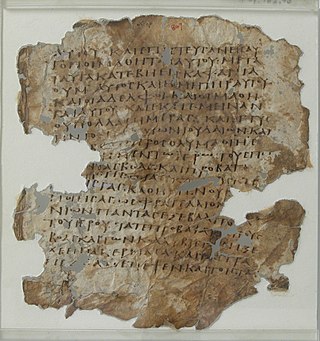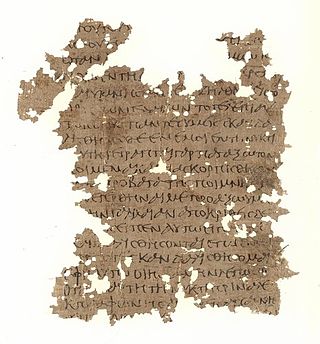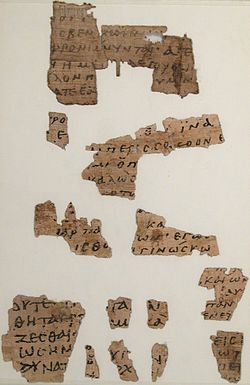
There have been many Coptic versions of the Bible, including some of the earliest translations into any language. Several different versions were made in the ancient world, with different editions of the Old and New Testament in five of the dialects of Coptic: Bohairic (northern), Fayyumic, Sahidic (southern), Akhmimic and Mesokemic (middle). Biblical books were translated from the Alexandrian Greek version.

Uncial 0162, ε 023, is one vellum leaf of a Codex containing The Gospel of John in Greek. It has been paleographically assigned a 3rd or 4th century CE date.
A biblical manuscript is any handwritten copy of a portion of the text of the Bible. Biblical manuscripts vary in size from tiny scrolls containing individual verses of the Jewish scriptures to huge polyglot codices containing both the Hebrew Bible (Tanakh) and the New Testament, as well as extracanonical works.

Codex Petropolitanus Purpureus, designated by N or 022, ε19, is a Greek New Testament codex containing the four Gospels written on parchment. Using the study of comparative writing styles (palaeography), it has been assigned to the 6th century CE.

Uncial 050, Cι1, is a Greek uncial manuscript of the New Testament, written on parchment. Palaeographically it has been assigned to the 9th century. Formerly it was labelled by O or We.
Papyrus 7, or ε 11, designated by 𝔓7, is an early copy of the New Testament in Greek. It is a papyrus manuscript of the Gospel of Luke 4:1-2. Possibly it is a patristic fragment. The manuscript had been difficult to date palaeographically, because of its fragmentary condition. It had been assigned to the 4th–6th century.

Papyrus 9, signed by 𝔓9, and named Oxyrhynchus papyri 402, is an early copy of the New Testament in Greek. It is a papyrus manuscript of the First Epistle of John, dating paleographically to the early 3rd century.
Papyrus 14, α 1036, signed by 𝔓14, is an early copy of the New Testament in Greek. It is a papyrus manuscript written in form of codex. The manuscript palaeographically has been assigned to the 5th century.

Papyrus 22, designated by 𝔓22, is an early copy of the New Testament in Greek. It is a papyrus manuscript of the Gospel of John, only containing extant John 15:25-16:2, 21–32. Using the study of comparative writings styles, (palaeography), the manuscript has been dated to the early 3rd century CE. It is the only identified New Testament papyrus to have been written originally as a roll; not a codex or re-using the back of a scroll.

Papyrus 23, designated by 𝔓23, is an early copy of the New Testament in Greek. It is a papyrus manuscript of the Epistle of James, it contains only James 1:10-12,15-18. The manuscript paleographically has been assigned to the early 3rd century.

Papyrus 38, designated by 𝔓38, is an early copy of part of the New Testament in Greek. It is a papyrus manuscript of the Acts of the Apostles, it contains only Acts 18:27-19:6.12-16. The manuscript paleographically has been assigned to the early 3rd century.

Papyrus 53, signed by 𝔓53, is an early copy of the New Testament in GreekBJ. It is a papyrus manuscript containing parts of the Gospel of Matthew and the Acts of the Apostles: it contains only Matthew 26:29-40 and Acts 9:33-10:1. The manuscript palaeographically had been assigned to the 3rd century. These two fragments were found together, they were part of a codex containing the four Gospels and Acts or Matthew and Acts.
Papyrus 59, signed by 𝔓59, is a copy of the New Testament in Greek. It is a papyrus manuscript of the Gospel of John. The manuscript has been palaeographically assigned to the seventh century.
Papyrus 60, signed by 𝔓60, is a copy of the New Testament in Greek. It is a papyrus manuscript of the Gospel of John, it contains John 16:29-19:26.
Papyrus 84, designated by 𝔓84, is a copy of the New Testament in Greek. It is a papyrus manuscript of the four Gospels. The surviving texts of Gospels are verses Mark 2:2-5,8-9; 6:30-31,33-34,36-37,39-41; John 5:5; 17:3,7-8. The manuscript paleographically has been assigned to the 6th century.

Papyrus 95, designated by siglum 𝔓95, is an early copy of the New Testament in Greek. It is a papyrus manuscript of the Gospel of John. The surviving texts of John are verses 5:26-29,36-38. The manuscript palaeographically has been assigned to the early 3rd century.

Papyrus 121, designated by 𝔓121, is an early copy of the New Testament in Greek. It is a papyrus manuscript of the Gospel of John. The surviving texts of John are only fragments of verses 19:17-18,25-26. They are in very fragmentary condition. The manuscript paleographically has been assigned to the 3rd century by the INTF.
Uncial 0301, is a Greek-Coptic diglot uncial manuscript of the New Testament. Paleographically it has been assigned to the 5th century.

Papyrus 128, designated by 𝔓128, is a copy of a small part of the New Testament in Greek. It is a papyrus manuscript of the Gospel of John, containing verses 9:3-4; 12:16-18. The manuscript paleographically has been assigned to the 6th or 7th century.












